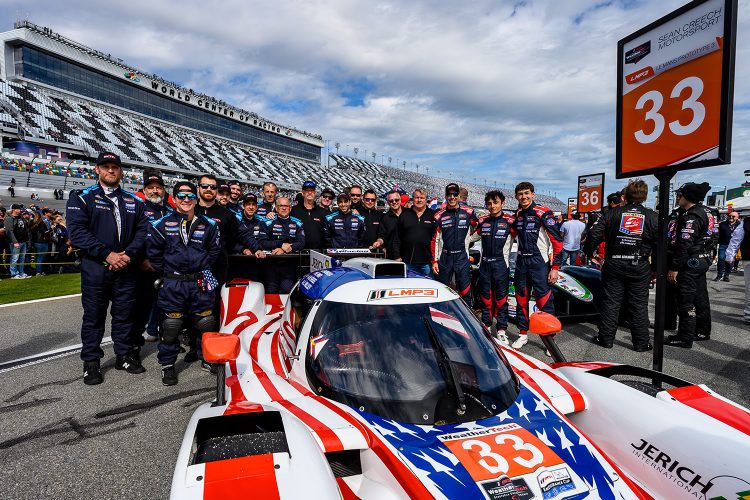Sean Creech Motorsport Rolex 24 Rewind: A Story of Teamwork and Grit

The Heart of Racing Opens 2023 Season with Team-First Daytona Victory
February 1, 2023Lime Rock Park helped Charlie Downes to a landmark in African-American Racing History
February 17, 2023The story of how the SCM team diagnosed and fixed a potentially race-ending issue – returning the No. 33 Ligier to the racetrack and a second-place finish in just 37.9 minutes – is a study in teamwork, perseverance, and determination.
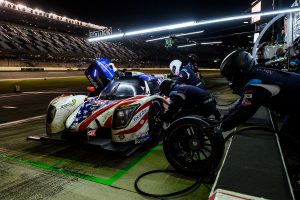 JUPITER, Fla. (9 February 2023) – Having finished second in the Rolex 24 two years in a row, Sean Creech Motorsport (SCM) went into the Rolex 24 At Daytona confident it had the car and the driver lineup to win the race in 2023. And after 19 hours, it appeared the team was well on its way. Drivers Lance Willsey, João Barbosa, Nico Pino and Nolan Siegel had battled hard, keeping the No. 33 SCM Exelixis/Focal One/Jerich International Ligier JS P320 at or near the front of the LMP3 class field.
JUPITER, Fla. (9 February 2023) – Having finished second in the Rolex 24 two years in a row, Sean Creech Motorsport (SCM) went into the Rolex 24 At Daytona confident it had the car and the driver lineup to win the race in 2023. And after 19 hours, it appeared the team was well on its way. Drivers Lance Willsey, João Barbosa, Nico Pino and Nolan Siegel had battled hard, keeping the No. 33 SCM Exelixis/Focal One/Jerich International Ligier JS P320 at or near the front of the LMP3 class field.
Coming off a spectacular stint by Barbosa that saw the four-time winner take the car from second position into a two-lap lead on the field, Siegel had taken the helm with the team’s instructions to play it smart and keep it clean.
The fates seemed to be lining up in the team’s favor – until they weren’t.
The story of how the SCM team diagnosed and fixed a potentially race-ending issue – returning the No. 33 Ligier to the racetrack and a second-place finish – is a study in teamwork, perseverance and determination.
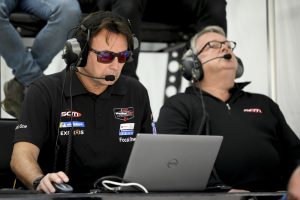 8:39.02 a.m.
8:39.02 a.m.
After a long night of grinding out the laps, the sun returned 90-minutes earlier.
Early in Siegel’s stint, he had gained another lap on the competition while sticking to his instructions: take care of the car.
Siegel was putting down solid laps in the 1:44-second range, halfway through his stint, when he radioed to the pit box, “I can’t shift.”
Race engineer Jim “Chachi” Malicki radioed back and asked for a repeat. The crackly reply on the radio came back: “I’m stuck in gear.” Powering through turn five, the car remained in fourth gear. The team brought him immediately to pit lane.
8:40.00 a.m.
The team began running through the checklist for a shifting issue as soon as Siegel hit the pit box, starting with the (relatively) simple fixes. They had experienced a steering wheel issue at a recent test, so crew chief Anthony Guida had Siegel try a new one as the crew took off the engine cover. Careful to have no more than four crew members over the wall (per IMSA regulations), Guida and mechanic/rear tire changer Adam Berberich began assessments at the back of the car, joined by car chief Stef Chistel and his brother Laurent – all under the watchful eyes of two cameramen broadcasting live on USA Network.
“We’re all experienced, so we were all thinking the same thing,” said Malicki. “Shift system, compressor, steering wheel, ECU – it would be one of those. The crew looked at the shift mechanism and the IVA and changed the ECU.”
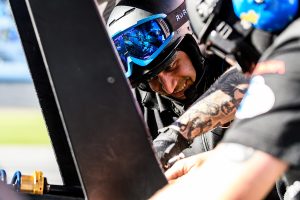 “Stef, Laurent and Adam all have a great deal of experience in handling issues quickly,” said Guida. “It’s process of elimination, so you start with the things that are the easiest to change, like the steering wheel. We thought either the ECU (electronic control unit) or the IVA (integrated valve actuator) – that’s why we practice those changes at the shop. We changed the ECU but that didn’t help.”
“Stef, Laurent and Adam all have a great deal of experience in handling issues quickly,” said Guida. “It’s process of elimination, so you start with the things that are the easiest to change, like the steering wheel. We thought either the ECU (electronic control unit) or the IVA (integrated valve actuator) – that’s why we practice those changes at the shop. We changed the ECU but that didn’t help.”
“A failed loom piece would not allow the wheel speed sensor to be logged,” added Malicki. “It’s written into the shifting strategies that the system needs to see both wheel speeds, so we knew that meant a trip back to the garage.”
The team rolled the No. 33 Ligier out of pit lane and began the long run back to the garage area.
8:50 a.m.
When the car reached space No. 54 in the Daytona Yellow garages, Guida, Berberich, and the Chistels took off the engine cover and swarmed the rear of the car. It quickly became apparent what had caused the issue.
“There are two flat straps that hold the u-bend from the collector to the silencer and the straps were worn through – even though we run two straps,” said team principal Sean Creech. “The exhaust came off and blew hot air back through the undertray, melting the wheel speed sensor wiring and damaging the IVA. So all that had to be changed out.”
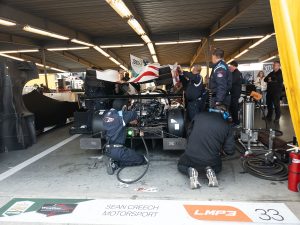 “The mechanics split up as soon as we got back to the garage,” said Guida. “I worked on the IVA and wheel speed sensor with Adam and Dave Martz from (transmission builders) Xtrac, and Stef and Laurent were on the exhaust. I was completely focused on what I was doing, and I was confident they would figure out the exhaust. Other guys ran back and forth to the transporter with parts and hardware, cleaned the windshield, and made sure we had everything we needed.”
“The mechanics split up as soon as we got back to the garage,” said Guida. “I worked on the IVA and wheel speed sensor with Adam and Dave Martz from (transmission builders) Xtrac, and Stef and Laurent were on the exhaust. I was completely focused on what I was doing, and I was confident they would figure out the exhaust. Other guys ran back and forth to the transporter with parts and hardware, cleaned the windshield, and made sure we had everything we needed.”
Siegel remained in the car throughout, desperately hoping to get back on track. “It’s everyone’s dream to win this race, so it was pretty disappointing at that point – to go from a three-lap lead, then suddenly we’re rolling back to the garage and seeing all that slip away.”
Once the IVA and wheel speed sensor were installed and the exhaust brackets were fixed, the team re-secured the engine cover and made final checks. Of central focus now was ensuring that the heat hadn’t damaged primary systems like brake lines. Once checks were done, the team and the No. 33 Ligier were ready to go.
9:17 a.m. / 37.9 minutes after the initial radio call
Siegel fired the engine, and headed back on track, albeit with a very different mindset. “At that point, all that “take care of the car” stuff just went away, and I was pushing as hard as I could for a couple of hours to make up as much as I could. It’s not often in an endurance race that you can go do qualifying-type laps! Everything that had happened, it was an emotional roller coaster, but I was so happy to be back in the race. Anything could have happened to the leader so there was plenty of motivation for all of us.”
The No. 33 Ligier returned to the racetrack just as powerful as it had left, with Siegel, Barbosa and Pino powering through the final four hours and 23 minutes of the race.
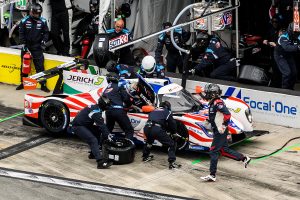 On lap 634, Siegel and the No. 33 set the quickest LMP3 time of the race, with a lap at 1:43.265.
On lap 634, Siegel and the No. 33 set the quickest LMP3 time of the race, with a lap at 1:43.265.
At the checkered flag, after 24 hours, the team had taken its third-straight second place finish – a remarkable, if bittersweet ending to a dominant performance.
“All four drivers raced so clean – there wasn’t a scratch on the car,” said Malicki. “They took such good care of the car; it was just an unfortunate mechanical issue.”
“There are still a lot of lingering questions but all I know is – we got it fixed, got it back out there and got a podium,” said Guida. “My main focus now is Sebring – and making sure it doesn’t happen again.”
SCM thanks partners Exelixis, Focal One and Jerich International for their continued support.
Next up for Sean Creech Motorsport will be the second of two home state events, the Mobil 1 Twelve Hours of Sebring March 11-18.

